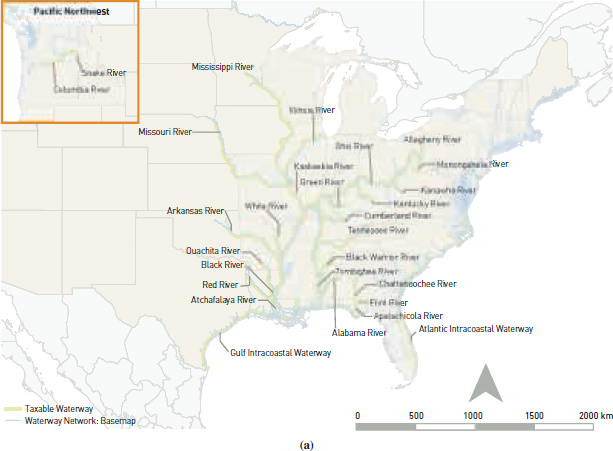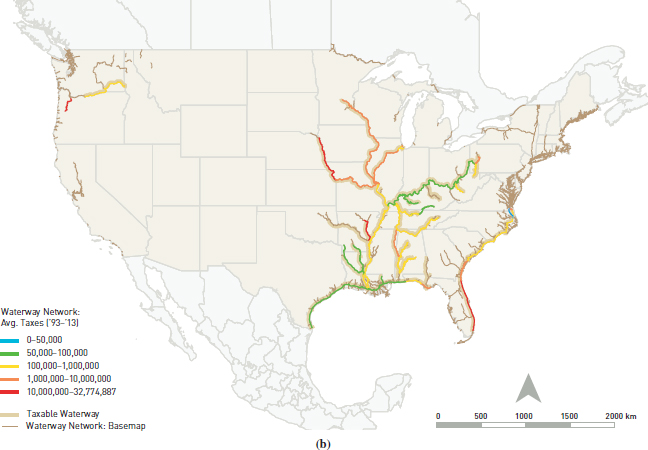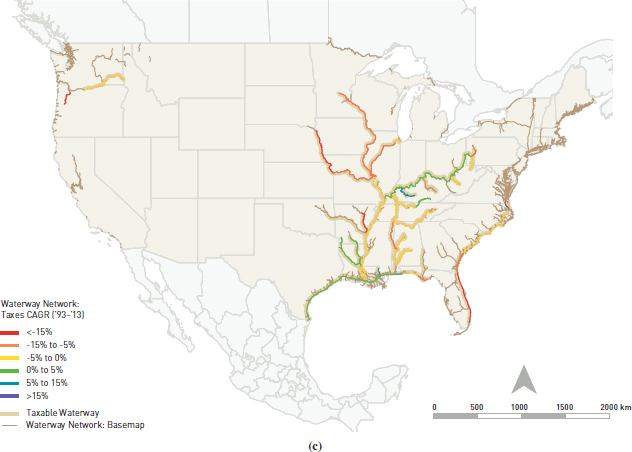![]()
Waterways subject to fuel taxes specified by Public Law 95-502, October 21, 1978, and Public Law 99-662, November 17, 1986 [source: Institute of Water Resources, U.S. Army Corps of Engineers (http://www.iwr.usace.army.mil/Missions/Navigation/InlandWaterwaysUsersBoard/FuelTaxedWaterways.aspx)]:
- Alabama–Coosa Rivers: From junction with the Tombigbee River at river mile (RM) 0 to junction with Coosa River at RM 314.
- Allegheny River: From confluence with the Monongahela River to form the Ohio River at RM 0 to the head of the existing project at East Brady, Pennsylvania, RM 72.
- Apalachicola–Chattahoochee and Flint Rivers: Apalachicola River from mouth at Apalachicola Bay (intersection with the Gulf Intracoastal Waterway), RM 0, to junction with Chattahoochee and Flint Rivers at RM 107.8. Chattahoochee River from junction with Apalachicola and Flint Rivers at RM 0 to Columbus, Georgia, at RM 155 and Flint River, from junction with Apalachicola and Chattahoochee Rivers at RM 0 to Bainbridge, Georgia, at RM 28.
- Arkansas River (McClellan–Kerr Arkansas River Navigation System): From junction with Mississippi River at RM 0 to Port of Catoosa, Oklahoma, at RM 448.2.
- Atchafalaya River: From RM 0 at its intersection with the Gulf Intracoastal Waterway at Morgan City, Louisiana, upstream to junction with Red River at RM 116.8.
- Atlantic Intracoastal Waterway: Two inland waterway routes approximately paralleling the Atlantic coast between Norfolk, Virginia, and Miami, Florida, for 1,192 miles via both the Albemarle and Chesapeake Canal and the Great Dismal Swamp Canal routes.

FIGURE A-1 Summary of (a) waterways where fuel taxes are collectible.
SOURCE: Dager 2013.

FIGURE A-1 Summary of (b) average fuel taxes collected.

FIGURE A-1 Summary of (c) compound annual growth rate over 1999–2011.
- Black Warrior–Tombigbee–Mobile Rivers: Black Warrior River system from RM 2.9, Mobile River (at Chickasaw Creek), to confluence with Tombigbee River at RM 45. Tombigbee River (to Demopolis, Alabama, at RM 215.4) to port of Birmingham, Alabama, RMs 374 to 411 and upstream to head of navigation on Mulberry Fork (RM 429.6), Locust Fork (RM 407.8), and Sipsey Fork (RM 430.4).
- Columbia River (Columbia–Snake Rivers Inland Waterways): From The Dalles at RM 191.5 to Pasco, Washington (McNary Pool), at RM 330; Snake River from RM 0 at the mouth to RM 231.5 at Johnson Bar Landing, Idaho.
- Cumberland River: Junction with Ohio River at RM 0 to head of navigation, upstream to Carthage, Tennessee, at RM 313.5.
- Green and Barren Rivers: Green River from junction with the Ohio River at RM 0 to head of navigation at RM 149.1.
- Gulf Intracoastal Waterway: From Saint Mark’s River, Florida, to Brownsville, Texas, 1,134.5 miles.
- Illinois Waterway (Calumet–Sag Channel): From the junction of the Illinois River with the Mississippi River at RM 0 to Chicago Harbor at Lake Michigan, approximately RM 350.
- Kanawha River: From junction with the Ohio River at RM 0 to RM 90.6 at Deep Water, West Virginia.
- Kaskaskia River: From junction with the Mississippi River at RM 0 to RM 36.2 at Fayetteville, Illinois.
- Kentucky River: From junction with the Ohio River at RM 0 to confluence of Middle and North Forks at RM 258.6.
- Lower Mississippi River: From Baton Rouge, Louisiana, RM 233.9, to Cairo, Illinois, RM 953.8.
- Upper Mississippi River: From Cairo, Illinois, RM 953.8, to Minneapolis, Minnesota, RM 1,811.4.
- Missouri River: From junction with the Mississippi River at RM 0 to Sioux City, Iowa, at RM 734.8.
- Monongahela River: From junction with the Allegheny River to form the Ohio River at RM 0 to junction of the Tygart and West Fork Rivers, Fairmont, West Virginia, at RM 128.7.
- Ohio River: From junction with the Allegheny and Monongahela Rivers at Pittsburgh, Pennsylvania, at RM 0 to junction with the Mississippi River at RM 981.1
- Ouachita–Black Rivers: From the mouth of the Black River at its junction with the Red River at RM 0 to RM 351 at Camden, Arkansas.
- Pearl River: From the junction of the West Pearl River with the Rigolets at RM 0 to Bogalusa, Louisiana, RM 58.
- Red River: From RM 0 to the mouth of the Cypress Bayou at RM 236.
- Tennessee River: From junction with the Ohio River at RM 0 to confluence with Holston and French Broad Rivers at RM 652.
- White River: From RM 9.8 to RM 255 at Newport, Arkansas.
- Willamette River: From RM 21 upstream of Portland, Oregon, to Harrisburg, Oregon, at RM 194.
- Tennessee–Tombigbee Waterway: From its confluence with the Tennessee River to the Warrior River at Demopolis, Alabama.
Reference
Dager, C. A. 2013. Fuel Tax Report, 2011. Center for Transportation Research, University of Tennessee, Knoxville.
________________
1 Public law incorrectly states that the Ohio River runs from junction with the Mississippi River at RM 0 to junction of the Allegheny and Monongahela Rivers at Pittsburgh, Pennsylvania, at RM 981; the correct information is provided here and was confirmed with Mark Pointon, U.S. Army Corps of Engineers, on January 8, 2015. Furthermore, for No. 24, public law refers incorrectly to Holstein and French Rivers, and for No. 27, public law refers incorrectly to Warrior River at Demopolis, Tennessee; both errors are corrected here.






